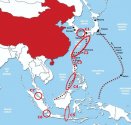It'll honestly be hard to turn that into a useful system for the PLA. This kind of lurking submarine works great for Europe, filled with choke points and lots of massed land-based air power and fires which force ships into narrow, predictable channels. In the expanse of the Pacific against the USN, these vessels would struggle to even remain in one place as it fights against the waves of the ocean. In the Pacific, you want systems that can move quickly like SSNs or airborne missiles/drones. USVs are much more useful for ensuring that any US submarine that wanders into the SCS gets found and sunk.
I think if China are to employ USVs and UUVs in war, it would be mainly within the First Island Chain, especially to guard and pluck all the chokepoints along the chain and transforming the chain into a protective ring.narrow, predicable channels like all the islands lining the rim of the East China Sea up to Okinawa? or the SCS? or the Straits of Malacca? or as a stealthy first strike weapon against the ECS facing ports of some certain regional powers?
In fact, there are many key chokepoints along the First Island Chain which PLAN USVs and UUVs should take advantage of, not just in the South China Sea:

Clockwise from C1 to C7:
1. Chokepoint 1 (C1) - The Korea Strait, which spans from South Korea (mainland Asia) in the west to Japan's Kyushu in the east through Tsushima Island.
2. Chokepoint 2 (C2) - Along the Ryukyu Islands, which spans from Japan's Kyushu in the north to Taiwan in the south. The Miyako Strait is among the larger spans of open water to consider.
3. Chokepoint 3 (C3) - The Luzon Strait, which spans from Taiwan in the north to the Philippines's Luzon in the south through the Batanes Islands.
4. Chokepoint 4 (C4) - Along the Palawan Islands, which spans from the Philippines's Luzon in the north to Malaysia's North Borneo in the south.
5. Chokepoint 5 (C5) - The eastern regions of the Java Sea, which spans from Indonesia's South Borneo in the north to Indonesia's Java in the south. Arguably, this is the longest span of open water with few islands along this chokepoint.
6. Chokepoint 6 (C6) - The Sunda Strait, which spans from Indonesia's Sumatra in the west to Indonesia's Java in the east.
7. Chokepoint 7 (C7) - The Malacca Strait, which spans from Indonesia's Sumatra in the west to Peninsular Malaysia (mainland Asia) in the east).
Any ships and submarines that enter or exit the regions within the First Island Chain (i.e. East China Sea and South China Sea) MUST past through any of these 7 chokepoints.
Therefore, these 7 chokepoints are where I believe the PLA should allocate some of their USVs and UUVs at, in order to defend and intercept any attempted warship and (particularly) submarine intrusions from outside the First Island Chain.
Last edited:
